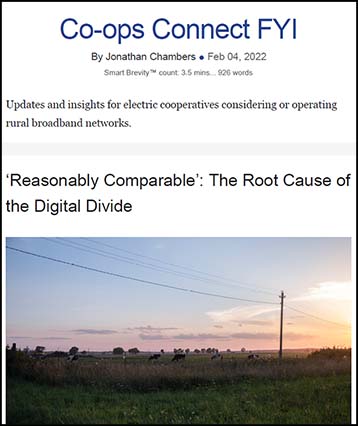‘Reasonably Comparable’: The Root Cause of the Digital Divide
February 2, 2022
Remember last week’s takeaway:
NTIA is charged with most of the Infrastructure Act implementation.
Open, public systems for broadband mapping, high-cost modeling, and Updates and insights for electric cooperatives considering or operating rural broadband networks.
Auction design are needed. NTIA should focus on tools usable by states and other federal agencies.
The Beginning of the Divide
First, a little common parlance and common sense:
- The “digital divide” is simply the gap between those who have access to high-speed internet and those who do not.
- Access has two components: availability and affordability.
- Universal service – service that is available and affordable for all – has been a tenet of telecommunications policy for more than a century.
- In 1996, Congress decided to codify the principle of universal service and directed the FCC and states to ensure universal availability and affordability of telecommunications (voice) and information services (including internet access).
- The concept was and is simple: if there is a divide, the FCC and states are charged with closing it.
Defining the Divide to Close It.
To determine what should be funded by universal service programs, the question must be: “What is available in urban areas?”
The second questions is: “What is reasonably comparable to service in urban areas?”
Federal law states:
“Consumers in all regions of the Nation, including low-income consumers and those in rural, insular, and high cost areas, should have access to telecommunications and information services…that are reasonably comparable to those services provided in urban areas and that are available at rates that are reasonably comparable to rates charged for similar services in urban areas.” {emphasis added} [excerpt from 47 U.S. Code § 254 - Universal Service, (b)(3) Access in Rural and High Cost Areas]
The bottom line: This is not the same as defining broadband. It is an inquiry into how to use public funds.
First, determine what is available in urban areas.
Then, adopt policies to ensure those services are available in rural areas and affordable to low-income consumers.
The Role of Universal Service
Recently, I heard a member of Congress say, “Why should government be involved in broadband? If someone in a rural area wants better broadband, they can move to a city.”
The country faces more than just a digital divide.
Sec. 254(c)(1) defines universal service:
“Universal service is an evolving level of telecommunications services that the Commission shall establish periodically under this section, taking into account advances in telecommunications and information technologies and services.”Go deeper: Availability is not viewed as a minimal standard of service.
- Dial-up internet service is still available, but we wouldn’t fund dial-up any more than we would fund party-line voice service.
- Nor do universal service programs fund experimental technology.
- Such speculation is the province of the private market.
The bottom line:
Universal service funding is meant to support services comparable to those that are widely available in urban areas and those that will be available taking into account advances in technology.
How do we know that?
The FCC and the states are charged with considering which services:
(A) are essential to education, public health, or public safety;
(B) have, through the operation of market choices by customers, been subscribed to by a substantial majority of residential customers;
(C) are being deployed in public telecommunications networks by telecommunications carriers
[excerpt from 47 U.S. Code § 254 (c)(1)]
The Billion-Dollar Questions
Determining what should be funded with $65 billion from the broadband provisions of the Infrastructure Act requires two questions:
1. What will be widely available in urban areas during the timeframe when the public funds are meant to last?
2. What is reasonably comparable to those services?
These questions haven’t been adequately answered over the past decade.
Go deeper: Over the past 10 years, Congress and the FCC have committed and spent over $100 billion on universal service programs.
Consider the following:
In 2010, the National Broadband Plan determined that 100 Mbps internet access service would be available to the vast majority of urban households.
Yet the FCC set 4 Mbps as the goal for rural America.
At 1/25th of speeds available in urban areas, was 4 Mbps reasonably comparable to 100 Mbps?
In 2015, Gigabit service was available to urban households.
Yet the FCC committed tens of billions in public funding for 10 Mbps.
At 1/100th of speeds available in urban areas, was 10 Mbps reasonably comparable to Gigabit service?
Today, AT&T Gigapower, Google Fiber, Conexon Connect, and others offer multi-gigabit symmetrical services: 2 Gigabits per second and 5 Gigabits per second symmetrical services.
In 2021, Congress proposed that infrastructure funds be used for 100 Mbps downstream and 20 Mbps upstream services.
At 1/250th of speeds available in urban areas, is 20 Mbps reasonably comparable to 2 Gbps or 5 Gbps service?
The bottom line:
The divide is widening.
Final Thought
How do we close the digital divide? Start with the experts:
- NTIA should convene a panel from the Internet Hall of Fame.
- Focus on people who helped create the Internet and have worked at the intersection of government policy and industry standards setting.
- Vint Cerf and Henning Schulzrinne would be two good candidates.
Ask the panel the two key questions:
1. What level of internet access will exist in urban areas in a decade’s time?
2. What will be reasonably comparable to that service?
Then, orient the Infrastructure Act funding to that.
